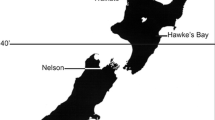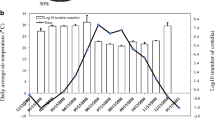Abstract
Four experiments were conducted with potted trees of several apple cultivars to study the effects of several factors on the incidence of canker and the length of the incubation period following the inoculation of pruning cuts with conidia of Nectria galligena. These factors included wound age (the interval between pruning and inoculation), inoculum dose and environment (wet-period temperature and duration). The most important factors affecting the incidence of canker and the incubation period were inoculum dose, cultivar and wound age. Low inoculum dose resulted in low incidence of canker. The incidence of canker decreased as the age of the pruning wound increased. The incubation period lengthened with low inoculum dose and increasing age of the wound. The degree of resistance related to the age of the wound varied with cultivar; likewise, it also varied with the time of year, but this was not due to temperature alone. On fresh wounds, the incidence of canker and the incubation period were not affected by temperature during the wet period. The effect of duration of wetness on canker incidence was significant in only one out of three experiments: the longer wet periods resulted in a slightly lower incidence on fresh wounds. In another experiment, wet periods longer than 2 h resulted in shorter incubation periods. The results are discussed in relation to wound healing.
Similar content being viewed by others
References
Alston FH (1970) Response of apple cultivars to canker, Nectria galligena. Report of East Malling Research Station for 1969 (pp 147-148), East Malling, UK
Baudoin ABAM and Exkert JW (1985) Development of resistance against Geotrichum candidumin lemon peel injuries. Phytopathol 75: 174-179
Biggs AR (1986) Prediction of lignin and suberin deposition in boundary zone tissue of wounded tree bark using accumulated degree days. J Am Soc Horticulture Sci 111: 757-760
Biggs AR and Miles NW (1985) Suberin deposition as a measure of wound response in peach bark. HortScience 20: 903-905
Biggs AR and Miles NW (1988) Association of suberin formation in uninoculated wounds with susceptibility to Leucostoma cincaand L. persooniin various peach cultivars. Phytopathol 78: 1070- 1074
Borecki Z and Czynczyk A (1984) Susceptibility of apple cultivars to bark canker diseases. Acta Agrobotanica 37: 49-59
Burmeister Von P and Kennel W (1967) Infektionsversuche mit Nectria galligena, Gloeosporium perennasand G. albuman Fruchtansatzstellen des Apfels in Verbindung mit chemischen Bekämpfungsversuchen. Zeitschrift für Pflanzenkrankheiten, Pflanzenpathologie und Pflanzenschutz 74: 615-626
Carter MW and Moller WJ (1971) The quantity of inoculum required to infect apricot and other Prunusspecies with Eutypa armeniacae. Australian J Agricult Anim Husbandry 11: 684-686
Cox DR and Snell EJ (1989) Analysis of binary data. 2nd edn. Chapman and Hall, New York
Crowdy SH (1949) A progress report on the effect of organic chemicals on the healing of wounds on apple. Annual Report of Long Ashton Research Station, 1948, p 155
Doster MA and Bostock RM (1988a) Susceptibility of almond cultivars and stone fruit species to pruning wound cankers caused by Phytophthora syringae.Plant Disease 72: 490-492
Doster MA and Bostock RM (1988b) Effects of low temperature on resistance of almond trees to Phytophthorapruning wound cankers in relation to lignin and suberin formation in wounded bark tissue. Phytopathology 78: 478-483
Dubin HJ and English H (1974) Factors affecting apple leaf scar infection by Nectria galligena. Phytopathology 64: 1201-1203
Dubin HJ and English H (1975a) Effects of temperature, relative humidity, and desiccation on germination of Nectria galligenaconidia. Mycologia 67: 83-88
Dubin HJ and English H (1975b) Epidemiology of European apple canker in California. Phytopathology 65: 542-550
El-Hamalawi ZA and Menge JA (1994) Effects of wound age and fungicide treatment of wounds on susceptibility of avocado stems to infection by Phytophthora citricola.Plant Disease 78: 700- 704
Graf H (1981) Fruhe Herbstfroste des Jahres 1980 als primaire Ursache fur Obstbaum Krebs-Infektionen. Erwerbsobstbau 23: 218-219
Grant TJ and Spaulding P (1939) Avenues of entrance for canker-forming Nectriasof new England Hardwoods. Phytopathology 29: 351-358
Heinrich E (1982) Untersuchungen zum Obstbaumkrebs (N. galligenaBres.). Wirksamkeit von Fungiziden und standortabhängige Anfälligkeit des Baumes. Dissertation, Hannover
Kennel W (1963) Zur pathogenes des obstbaumkrebes (Nectria galligenaBres.) am apfel. Gartenbauwissenschaft 28: 29-64
Krähmer H (1980) Wundreaktionen von Apfelbäumen und ihr Einflußauf Infektionen mit Nectria galligena. Zeitschrift für Pflanzenkrankheiten und Pflanzenschutz 87: 97-112
Krähmer H and Schmidle A (1979) Über die Anfälligkeit einiger neuerer Apfelsorten für Nectria galligenaBres. und Phytophthora cactorum(Leb. et Cohn) Schroet. Nachrichtenblatte Deutscher Pflanzenschutzdienst (Stuttgart) 31: 89-92
Krüger J (1983) Anfälligkeiten von Apfelsorten und Kruzungsnachkommenschaften für den Obstbaumkrebs nach natürlicher und künstlicher Infektion. Erwerbsobstbau 25: 114-116
Marsh RW (1939) Observation on apple canker II. Experiments on the incidence and control of shoot infections. Ann Appl Biol 26: 458-469
Mullick DB (1975) A new tissue essential to necrophylactic periderm formation in the bark of four conifers. Canadian J Bot 53: 2443-2457
Mullick DB (1977) The non-specific nature of defense in bark and wood during wounding, insect, and pathogen attack. Recent Advances in Phytochemistry 11: 395-441
Mullick DB and Jenson GD (1976) Rates of non-suberized impervious tissue development after wounding at different times of the year in three conifer species. Canadian J Bot 54: 881-892
Pedersen HL, Christensen JV and Hansen P (1994) Susceptibility of 15 apple cultivars to apple scab, powdery mildew, canker and mites. Fruit Varieties Journal 48: 97-100
Saure M (1962) Untersuchungen über die Voraussetzungen für ein epidemisches Auftreten des Obstbaumkrebses (Nectria galligenaBres.). Mitteilungen der Obstbauversuchanstalt, Jork 1: 1-74
Seaby DA and Swinburne TR (1976) Protection of pruning wounds on apple trees from Nectria galligenaBres. Using modified pruning shears. Plant Pathology 25: 50-54
Skene DS (1981) Wound healing in apple fruits: the anatomical response of Cox's Orange Pippin at different stages of development. Journal of Horticultural Science 56: 145-153
Swinburne TR (1971) The seasonal release of spores of Nectria galligenafrom apple cankers in Northern Ireland. Annals of Applied Biology 69: 97-104
Swinburne TR (1975) European Canker of Apple (Nectria galligena). Review of Plant Pathology 54: 787-799
Tamura O and Saito I (1982) Histopathological changes of apple bark infected by Valsa ceratosperma(Tode ex Fr.) Maire during dormant and growing periods. Annals of Phytopathological Society of Japan 48: 490-498
Weg van de WE (1989) Screening for resistance to Nectria galligenaBres. in cut shoots of apple. Euphytica 42: 233-240
Weg van de WE, Giezen S and Jansen RC (1992) Influence of temperature on infection of seven apple cultivars by Nectria galligena. Acta Phytopathologica et Entomologica Hungarica 27: 631-635
Wilson EE (1966) Development of European canker in a California apple district. Plant Disease Reporter 50: 182-186
Wilson EE and Nichols CW (1964) European canker of apple. California Department of Agriculture Bulletin 53: 151-153
Wiltshire SP (1921) Studies on the apple canker fungus. I Leaf scar infection. Annals of Applied Biology 8: 182-192
Zagaja SW, Millikan DF, Kaminski W and Myszka T (1971) Field resistance to Nectriacanker in apple. Plant Disease Reporter 55: 445-447
Author information
Authors and Affiliations
Rights and permissions
About this article
Cite this article
Xu, XM., Ridout, M. The effects of inoculum dose, duration of wet period, temperature and wound age on infection by Nectria galligena of pruning wounds on apple. European Journal of Plant Pathology 104, 511–519 (1998). https://doi.org/10.1023/A:1008689406350
Issue Date:
DOI: https://doi.org/10.1023/A:1008689406350




